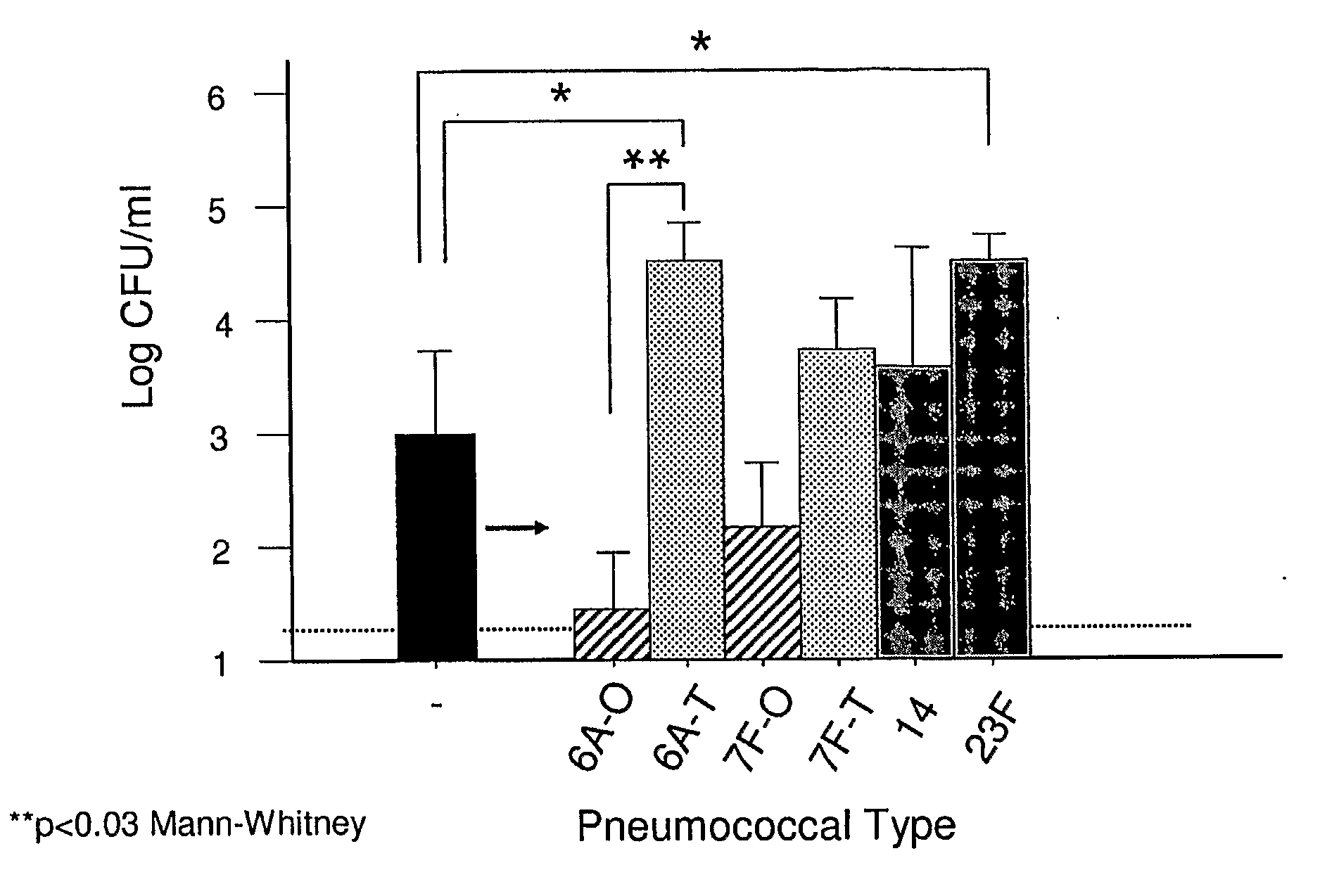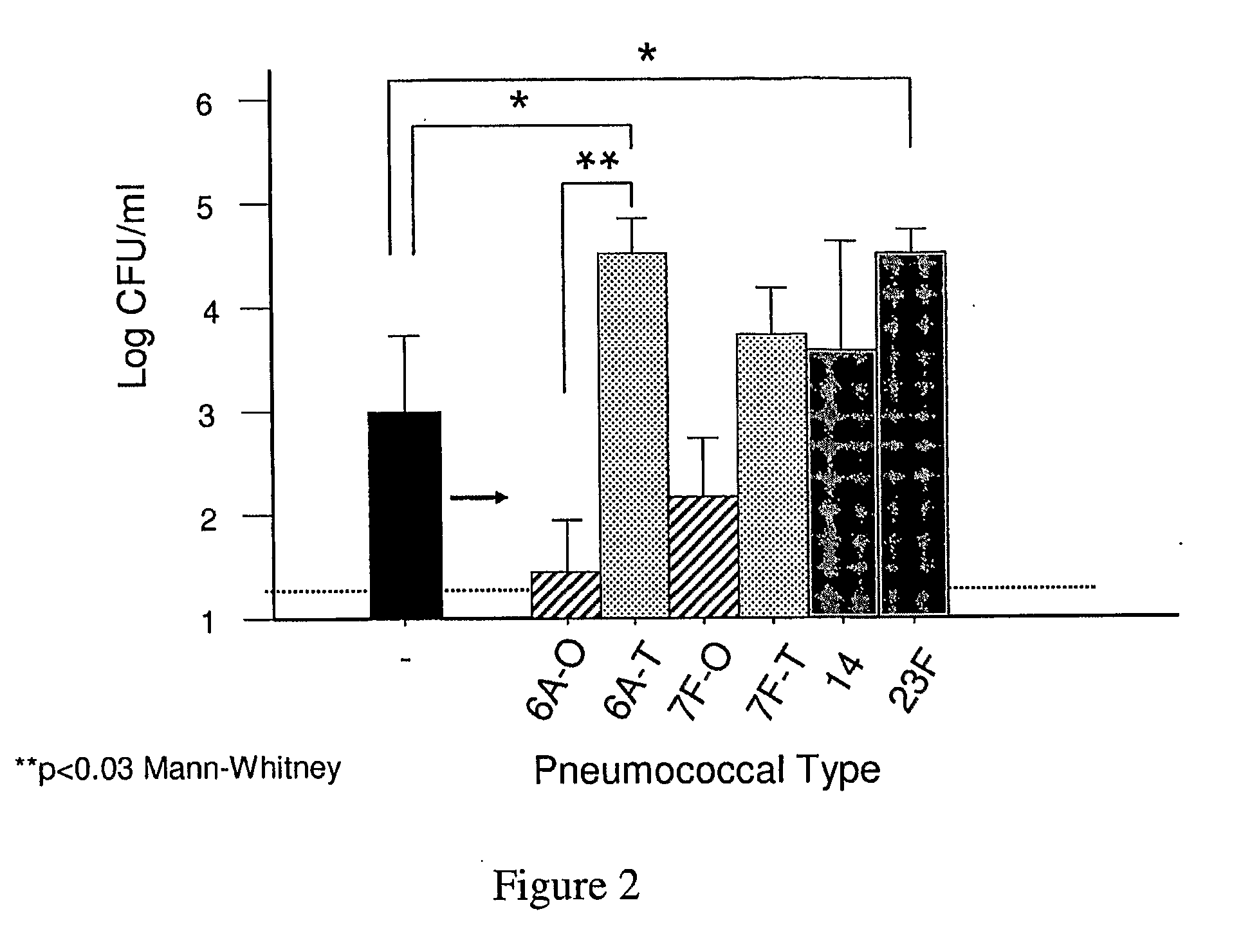Live, attenuated pneumococcal vaccine
a pneumococcal vaccine and attenuated technology, applied in the field of vaccines, can solve the problems of vaccine effectiveness in young children, large limitations of conjugate vaccines, and overall impact of vaccines that remain controversial
- Summary
- Abstract
- Description
- Claims
- Application Information
AI Technical Summary
Benefits of technology
Problems solved by technology
Method used
Image
Examples
example 1
Unencapsulated Mutants Colonize the Nasal Spaces
[0085]The contribution of capsule during colonization was assessed by comparing encapsulated isolates with their isogenic unencapsulated mutants in a murine model of colonization following intranasal inoculation. Mutants lacking cps were generated by use of Janus cassette technology that allows for construction of unmarked, in-frame deletions. TIGR4cps- consistently colonized C57BL / 6 mice but at a density 10 to 100-fold less compared to its parent strain in quantitative culture of upper airway lavages at 2 d post-inoculation (FIG. 1). A similar contribution of encapsulation to colonization was also demonstrated by comparison of isolates of other types (2 and 6A) with and without cps.
[0086]To confirm that the decrease in fitness for colonization was due to the loss of the capsule, the deletion of cps in TIGR4 was corrected by insertion of the cps locus derived from heterologous pneumococcal types. Correction of capsule expression was su...
example 2
Capsule does not Impact on Opsonophagocytosis Clearance During Colonization
[0088]Histological examination of colonized nasal tissues confirmed that colonizing pneumococci induce neutrophil influx into lateral nasal spaces by 1 d with a maximal response by 3 d post-inoculation. Immunoflourescent staining of frozen tissue to detect bacteria demonstrates that these dense clusters of neutrophils have engulfed pneumococci, but that not all pneumococci become associated with neutrophils (data not shown). To test whether neutrophil-mediated clearance accounted for the lower density of colonization by unencapsulated pneumococci, mice were treated with RB6-8C5, a rat mAB to murine Ly6.G prior to intranasal challenge(23). This effectively depleted neutrophils from peripheral blood and in tissue sections of colonized mice (data not shown). It was predicted that this treatment would decrease opsonophagocytic clearance and allow for enhanced colonization by unencapsulated pneumococci. However, t...
example 3
Effect of Capsule on the Dynamics of Colonization
[0089]To define the role of capsule in pneumococcal colonization, the events during the initial 2d period post-inoculation, during which the majority of the deficit in colonization by unencapsulated mutants develops, were visualized in tissue sections. For TIGR4, initially (time=30 min) bacteria are confined to the lumen of nasal spaces were they associate with amorphous material (FIG. 5A). This luminal material is mucus based on its staining with alcian blue that identifies acidic mucopolysaccharides (FIG. 5C). By 2d post-inoculation, these encapsulated pneumococci had transited to the mucosal surfaces where they were found in the thin mucus layer overlying epithelial cells (FIG. 5B, D). At later time points up to 14 d, pneumococci remained in the mucus layer over the epithelial cells indicating that this was the site of stable colonization. Unencapsulated mutants were also seen initially in the luminal mucus (T=30 minutes), but unli...
PUM
| Property | Measurement | Unit |
|---|---|---|
| Immunogenicity | aaaaa | aaaaa |
| Strain point | aaaaa | aaaaa |
Abstract
Description
Claims
Application Information
 Login to View More
Login to View More - R&D
- Intellectual Property
- Life Sciences
- Materials
- Tech Scout
- Unparalleled Data Quality
- Higher Quality Content
- 60% Fewer Hallucinations
Browse by: Latest US Patents, China's latest patents, Technical Efficacy Thesaurus, Application Domain, Technology Topic, Popular Technical Reports.
© 2025 PatSnap. All rights reserved.Legal|Privacy policy|Modern Slavery Act Transparency Statement|Sitemap|About US| Contact US: help@patsnap.com



